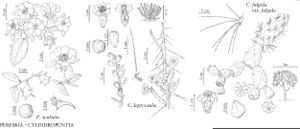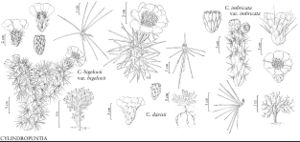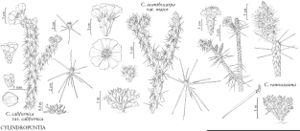Cylindropuntia
in C. Backeberg and F. M. Knuth, Kaktus-ABC, 410. 1935.
Trees or shrubs, rarely forming mats, erect, usually many branched. Stem segments firmly attached to easily dislodged, straight to curved, cylindric to slightly clavate, 2–40 (–50) × 0.3–5.5 cm, usually glabrous, tuberculate; areoles elliptic, circular, ovate, obovate, or obdeltate to rhombic, 0.7–5 mm diam.; wool white, yellow, or tan to brown. Spines with whole epidermis sheath deciduous; major spines not or only basally angularly flattened. Glochids usually in tuft at adaxial margin, yellow to brown. Flowers bisexual or sometimes functionally pistillate, radially symmetric; outer tepals green with margins tinged color of the inner; inner tepals yellow-green, yellow to bronze, or red to magenta, spatulate, emarginate-apiculate. Pollen spinulo-punctate, not reticulate (cylindropuntioid type). Fruits, if fleshy, green, yellow, or scarlet, sometimes tinged red to purple or, if dry, tan to brown, cylindric to subspheric, sometimes clavate, fleshy or dry, spineless or spiny; areoles bearing short feltlike wool of various colors, often tan or gray. Seeds pale-yellow to tan or gray, flattened to subspheric, angular to squarish or circular, often warped, 1.9–7 mm, commonly bearing 1–4 large depressions per side due to pressure from adjacent developing seeds, glabrous; funicular girdle smooth or with low marginal ridge. x = 11.
Distribution
sw and sc United States, Mexico, West Indies, to South America (Chile) and South Africa, to South America (Ecuador) and South Africa, to South America (Peru) and South Africa, and widely cultivated
Discussion
Species ca. 35 (22 in the flora).
Interspecific cholla hybrids are known, and many have been named. Only two are fully treated here: Cylindropuntia ×kelvinensis, because it is so widespread, and C. ×tetracantha, because it has been confused with other hybrids. Additional named hybrids are described briefly and cross-referenced under the putative parental taxa entries.
Selected References
Lower Taxa
Key
| 1 | Fruits (and flowers) spiny; fruits dry at maturity, spiny (spineless to nearly so and usually slowly drying in C. abyssi, C. acanthocarpa var. thornberi, C. californica, and C. munzii), tuberculate, greenish yellow, maturing tan or grayish tan | > 2 |
| 1 | Fruits and flowers spineless, only bearing deciduous glochids (or sometimes bearing 1-few spines per fruit, particularly in hybrids between fleshy and dry-fruited species); fruits fleshy at maturity, tuberculate or smooth, green, yellow, or scarlet, sometimes red or purple tinged | > 10 |
| 2 | Fruits burlike, with fine bristlelike spines; stem areoles usually deltate-linear, glochid-bearing portion apical, wedged distally between bases of 2 adjacent rhombic to squarish tubercles | Cylindropuntia ramosissima |
| 2 | Fruits (spineless to) spiny to burlike, with stoutish spines; stem areoles elliptic to subcircular, glochid-bearing portion not prolonged apically; tubercles oblong to linear | > 3 |
| 3 | Spines 0-few per fruit (deciduous glochids may also be present); fruits not burlike | > 4 |
| 3 | Spines many per fruit; fruits sometimes burlike | > 7 |
| 4 | Filaments red; tepals yellow to bronze or brick red; trees; stem tubercles 2.5- 4.5 cm; Arizona | Cylindropuntia acanthocarpa |
| 4 | Filaments green or yellow; tepals yellow or pale greenish maroon-brown; trees or shrubs; stem tubercles 0.6-1.8(-3.5) cm; California and Arizona | > 5 |
| 5 | Inner tepals pale reddish maroon-brown; trees erect, (1-)2-4 m | Cylindropuntia munzii |
| 5 | Inner tepals greenish yellow to yellow; small shrubby trees or shrubs decumbent to erect, to 1-2.5 m | > 6 |
| 6 | Inner tepals yellow, outer ones often tipped red; fruits with basal tubercles longer than distal ones; shrubs decumbent to erect, essentially trunkless; California, Mexico | Cylindropuntia californica |
| 6 | Inner tepals pale to greenish yellow, outer ones not tipped red; fruits with tubercles subequal in length; shrubby trees; n to c Arizona | Cylindropuntia abyssi |
| 7 | Filaments green or yellow, sometimes tinged maroon; inner tepals yellow to yellow-green or maroon; fruit tubercles nearly subequal | > 8 |
| 7 | Filaments red to magenta; inner tepals yellow, bronze, magenta, pale purple-brown to brick red; fruit tubercles subequal or usually basal ones longer | > 9 |
| 8 | Major branches strict, ascending; terminal stem segments usually 10-26 cm; stem tubercles usually 1.3-2.6 cm; inner tepals greenish yellow, often with tips reddish abaxially | Cylindropuntia ganderi |
| 8 | Major branches spreading; terminal stem segments usually 3-7.5 cm; stem tubercles usually 0.4-1.5 cm; inner tepals yellow, green to yellowish green, or reddish maroon | Cylindropuntia echinocarpa |
| 9 | Filaments red; inner tepals yellow, bronze, magenta to brick red; dense to open shrubs or trees, without strongly ascending branches; terminal stem segments 2-2.5(-3) cm diam.; tubercles 1.5-4.5 cm | Cylindropuntia acanthocarpa |
| 9 | Filaments magenta; inner tepals yellow-green, suffused bronze to pale purple-brown; essentially low dense shrubs, usually with strongly ascending branches; terminal stem segments 2.5-4 cm diam.; tubercles 1-1.5(-2) cm | Cylindropuntia wolfii |
| 10 | Terminal stem segments usually alternate, narrow, 0.7-1.4 cm diam.; large spines 0-4(-6) per areole | > 11 |
| 10 | Terminal stem segments commonly whorled or subwhorled, thicker, usually 1.5-5.5 cm diam. (0.8-1.2 cm in C. davisii); large spines usually 6-30+ per areole | > 14 |
| 11 | Stem tubercles inconspicuous (usually appearing as longitudinal wrinkles when dried); large spines 0-2(-3) per areole; fruits smooth | > 12 |
| 11 | Stem tubercles conspicuous; large spines usually (0-)2-4 per areole; fruits tuberculate | > 13 |
| 12 | Flowers yellow to greenish yellow, 5-8 mm; fruits yellow to scarlet at maturity, usually 9-15 mm; stems distally bearing numerous laterally arranged branches | Cylindropuntia leptocaulis |
| 12 | Flowers green- or orange-bronze, 17-20 mm; fruits pale green, becoming yellowish apically, sometimes tinged red to purple, 20-50 mm; stems distally bearing 0 to few laterally arranged branches | Cylindropuntia arbuscula |
| 13 | Tepals greenish bronze or red to magenta; some fruits bearing few short spines; Sonoran Desert | Cylindropuntia ×tetracantha |
| 13 | Tepals reddish bronze, tinged magenta; fruits spineless; Chihuahuan Desert | Cylindropuntia kleiniae |
| 14 | Fruits smooth to shallowly tuberculate, green to yellow-green, sometimes tinged red to purple at maturity, usually forming long chains, sometimes solitary | > 15 |
| 14 | Fruits strongly tuberculate, yellow or yellow-green (sometimes tinged red to purple) at maturity, solitary, not proliferating (or chain of 2 in C. davisii) | > 18 |
| 15 | Flowers yellow-green, yellow to gold or bronze, or red to rose or magenta; tubercles narrowly elongate; stems narrow, 1-2 cm diam | Cylindropuntia versicolor |
| 15 | Flowers magenta to pink; tubercles broadly oval; stems thick, usually 2-5 cm diam | > 16 |
| 16 | Fruits forming long, pendent chains; anthers white to cream; inner tepals pink to magenta, 12-16 mm | Cylindropuntia fulgida |
| 16 | Fruits solitary or forming short, erect to pendent chains of 2-5 fruits; anthers yellow; inner tepals rose to magenta, to 25(-30) mm | > 17 |
| 17 | Plants wide-branching trees; stem segments green to purple, 1.8-3 cm diam.; tubercles usually 0.7-1.2 cm; s to c Arizona | Cylindropuntia ×kelvinensis |
| 17 | Plants compact shrubs or small trees; stem segments greenish gray, 3.5-5 cm diam.; tubercles 1.5-2.5 cm; s California, Baja California | Cylindropuntia prolifera |
| 18 | Stem segments easily detached; spines obscuring stem; flowers pale green to yellow, sometimes edged reddish purple or aging bronze to reddish brown | > 19 |
| 18 | Stem segments firmly attached; spines not or little obscuring stem (except some forms of C. whipplei); flowers yellow, salmon, or rose to magenta | > 21 |
| 19 | Spine sheaths not baggy; small trees with proximal branches dark brown, clinging to usually solitary exposed trunk; stem tubercles 0.4-0.8 cm; Sonoran and Mojave deserts | Cylindropuntia bigelovii |
| 19 | Spine sheaths very baggy; shrubs with uniform branches obscuring trunks; stem tubercles 1-3 cm; Chihuahuan Desert and Great Plains | > 20 |
| 20 | Stems 1.5-2.5 cm diam.; tubercles 2-3 cm; filaments yellowish | Cylindropuntia tunicata |
| 20 | Stems 0.8-1.2 cm diam.; tubercles 1-2 cm; filaments green to purplish | Cylindropuntia davisii |
| 21 | Trees sparingly to densely branched, small, 0.3-0.6(-1.5) m, grading into compact shrubs; flowers yellow to yellow-green; spines of 2 kinds, smaller radial spines sur- rounding 4(-6) larger central spines arranged in a cross | Cylindropuntia whipplei |
| 21 | Trees openly branched, medium to large; flowers usually rose to magenta (sometimes white in O. imbricata or whitish, yellow, or salmon in C. spinosior); spines subequal or, if some longer, none arranged in a cross | > 22 |
| 22 | Tubercles of stems usually 0.5-1.5 cm, crowded; fruits with 28-50+ areoles, tubercles longer in distal portion of fruit | Cylindropuntia spinosior |
| 22 | Tubercles of stems usually 2-5 cm, widely spaced; fruits with 18-30 areoles, tubercles nearly equal in length or longer in proximal portion of fruit | Cylindropuntia imbricata |


